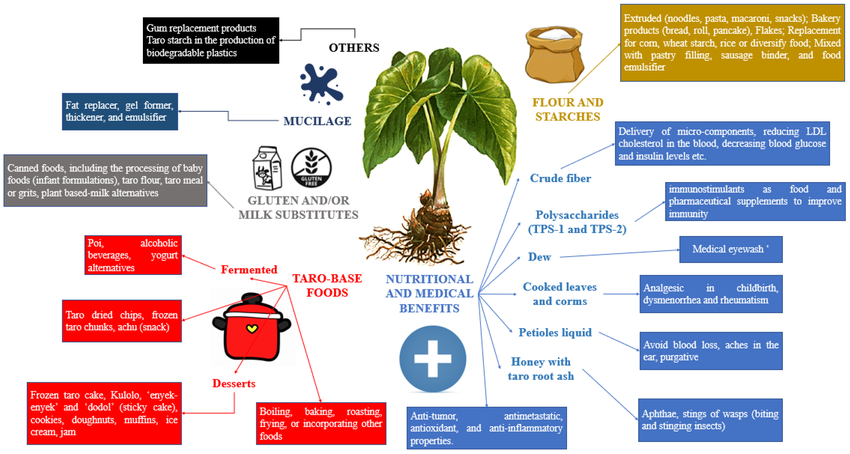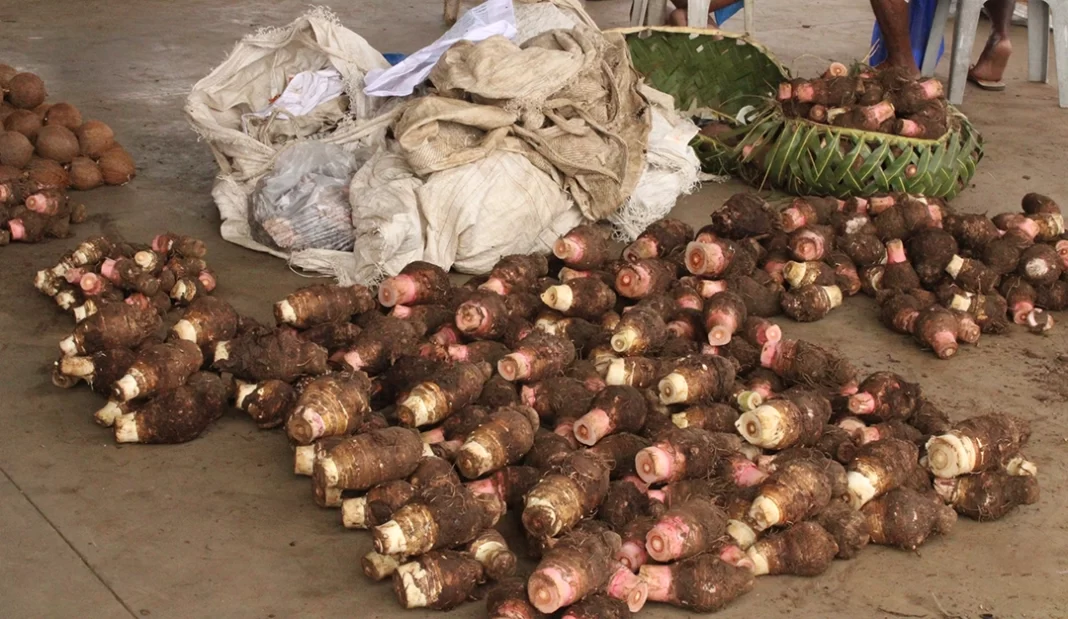Taro (Colocasia esculenta) has been cultivated for thousands of years, originating in Southeast Asia and spreading to the Pacific Islands, Africa, and beyond. Its adaptability and nutritional profile make it a staple in various cuisines and a symbol of sustainability.
Understanding taro
Taro is a starchy root vegetable with a slightly sweet and nutty flavour. Both the corms (roots) and leaves are edible when properly cooked, offering diverse culinary applications. However, raw taro contains calcium oxalate crystals, which can cause irritation. Cooking neutralises these compounds, making the plant safe to consume.
Taro in the pacific islands
In the Pacific Islands, including Samoa, taro (talo) holds a deeply rooted cultural and nutritional significance. It has been a cornerstone of the traditional diet for centuries, revered not only as a vital food source but also as an integral part of cultural identity and ceremonial practices. The preparation and sharing of taro in Samoa symbolize community and familial bonds, reflecting its value beyond nutrition.
Nutritional profile
Taro is an excellent source of complex carbohydrates, dietary fiber, and essential nutrients. It contains potassium, magnesium, and vitamins such as C and E. These components support heart health, regulate blood sugar levels, and strengthen the immune system. Resistant starch in taro also serves as a prebiotic, feeding beneficial gut bacteria and potentially reducing inflammation.
Potential health benefits and underestimated properties
While taro is already recognized for its dietary benefits, it may hold untapped potential in areas like disease prevention and gut health. Compounds such as polyphenols and antioxidants in taro are known to combat oxidative stress, which is linked to cancer and other chronic conditions. Some researchers suggest that taro’s anti-inflammatory properties could reduce risks of diseases such as colon cancer. However, modern scientific studies on taro remain limited, leaving much of its potential underexplored.
Taro’s ability to support gut health through its fiber and resistant starch is particularly promising. These components promote the production of short-chain fatty acids like butyrate, which may have protective effects against colon cancer. Further research into these mechanisms could provide more insights into its potential health applications.
Culinary applications
Taro is widely used across cultures in dishes such as:
- Hawaiian Poi: Taro is pounded into a paste, creating a traditional Polynesian staple.
- Stews and Curries: Absorbs flavors well, enhancing the richness of savory dishes.
- Taro Chips: A crispy, healthier alternative to potato chips.
- Desserts: Common in Southeast Asian sweets, including ice creams and cakes.
In Samoa, taro is often baked or boiled and paired with dishes like palusami, a savory combination of taro leaves, coconut cream, and onions. The leaves themselves are cooked thoroughly and incorporated into other local recipes, adding nutritional value.

Sustainable agriculture
Taro thrives in wetlands and marginal soils, making it a resilient crop. It requires minimal chemical inputs, supports biodiversity, and contributes to food security in areas prone to climate challenges. Its entire plant can be utilized, reducing agricultural waste. This adaptability positions taro as a critical resource for sustainable farming in the face of climate change.
Traditional and modern significance
In traditional medicine, taro has been used for its believed healing properties. Pacific Island cultures, particularly in Samoa, regard taro as a symbol of life and sustenance. Modern science validates its health benefits, emphasising its role in promoting digestive health, stabilising blood sugar, and enhancing skin repair.
Taro’s historical value and potential applications in modern health research highlight the need for greater attention from global health authorities. The crop’s rich cultural significance and nutritional advantages make it a prime candidate for further study and advocacy.
Challenges and considerations
Despite its benefits, taro faces challenges such as:
- Disease Susceptibility: Taro blight is a significant threat to its cultivation.
- Market Accessibility: Fresh taro is often less available in urbanized regions.
- Preparation Time: The need for thorough cooking can be a barrier for some consumers.
Addressing these issues through agricultural innovation and education can amplify taro’s role in global food systems.
The Untapped Potential of Taro

The article “Taro Roots: An Underexploited Root Crop” covers the taro’s rich nutritional profile, including carbohydrates, dietary fiber, vitamins, and minerals, positioning it as a valuable yet underutilised food source. Despite its abundance and affordability, taro remains undervalued compared to other root vegetables. The authors advocate for increased utilisation of taro in developing food products like plant-based milk alternatives and yogurt substitutes to enhance food security and nutrition. They also call for further research to explore taro’s applications and improve processing conditions for industrial purposes.
The potential of taro may be underestimated, particularly by mainstream health authorities and researchers. Limited modern studies leave many of its benefits underexplored, especially in areas like cancer prevention, gut health, and sustainable agriculture. Advocating for more research on traditional crops like taro could unlock its full potential and reshape global health narratives.
Taro’s enduring importance stems from its nutritional value, cultural significance, and sustainability. In the Pacific Islands, like Samoa, where it is most valued, taro continues to be a vital link to tradition and health. As a versatile superfood, it offers a pathway toward healthier diets and more resilient agriculture.





